Overview
What is this tool?
Scout is ETO's discovery tool for Chinese-language writing on science and technology. Scout compiles, tags, and summarizes news and commentary from selected Chinese sources, helping English-speaking users easily keep up to date, skim the latest news, and discover new perspectives. Use the Scout web interface to browse and filter articles, or have customized updates delivered to your inbox through our email service.
What can I use it for?
Use Scout to:
- Keep up with new developments in Chinese science and technology. Scout is updated regularly based on the latest news and commentary from leading Chinese-language sources. Email digests are available daily, weekly, or monthly.
- Hear about topics, perspectives and trends often missing from English-language coverage. Scout compiles writing from diverse Chinese-language sources, from news articles in official media to op-eds, commentaries, and interviews from privately run tech outlets and think tanks.
- Identify specific articles for further review. Scout's summaries and topical tags help you skim quickly and pinpoint the articles that interest you most. Access the original sources as well as machine translations with a single click from the Scout web interface.
Get updates
What are its most important limitations?
- Scout isn't comprehensive. Scout includes articles from several different Chinese-language sources, not the entire Chinese-language internet. Also, Scout doesn't include all of the content from these sources. Articles are selected for inclusion based on defined criteria as well as our own editorial judgment. We try to include a wide range of writing relevant to critical science and technology issues, but Scout isn't comprehensive or representative of all Chinese-language writing on these topics.
- Scout integrates machine translation and summarization, which may introduce errors. We use machine learning models to help translate metadata, such as titles and authors, and to summarize articles. Model outputs are reviewed by humans, but may still include errors. We believe the models we use are accurate enough to be useful for Scout's overall purpose of enabling discovery and skimming, but they aren't 100% reliable.
- Scout doesn't include the full text of articles. Scout is built for discovery and skimming. If you want to read full text, use the links in Scout to access the original sources.
- Scout isn't designed for complex or quantitative analysis. We don't provide a bulk dataset of the articles or metadata included in Scout. Because of this, and because Scout isn't comprehensive in the first place (see above), we don't recommend using Scout for complex or quantitative analysis.
What are its sources?
Scout compiles writing from diverse Chinese-language sources, from news articles in official media to op-eds, commentaries, and interviews from privately run tech websites and think tanks. Summaries, tags, and other metadata for each article are added using automated and manual processes. Read more >>
Does it contain sensitive information, such as personally identifiable information?
No. Although individuals may be discussed in some article summaries, all of the information in Scout has already been published in at least one prominent Chinese-language outlet.
What are the terms of use?
Scout is subject to ETO's general terms of use. If you rely on Scout in your work, please cite us.
How do I cite it?
If you cite articles that you discovered with Scout, please consider linking to the relevant article page(s) in Scout and crediting the "Emerging Technology Observatory Scout service" (with the link). We suggest the following format:
[Full citation to original article in appropriate format.] Located via the Emerging Technology Observatory Scout service at [Link to Scout article page].
We don't generally recommend citing Scout summaries directly in published work, since they are meant for discovery and skimming and may include errors from machine translation or summarization. For more informal use (e.g., posting on social media), feel free to share direct links to Scout article pages.
Using Scout
How do I use it?
Scout is available in two formats: a web interface and an email service.
The web interface
Scout's web interface displays articles in reverse chronological order. Articles are initially collapsed to show titles, basic details, tags, and a short summary only. Click on the article to open an expanded view with a longer summary, additional Chinese and English metadata, and links to the full article.
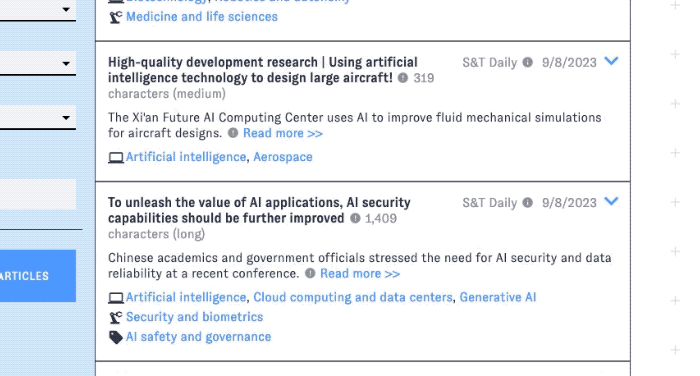
Scout includes links to the full article via the original source, Google Translate, and the Wayback Machine. Opening any of these links will take you to an external website. An alert will display to remind you.
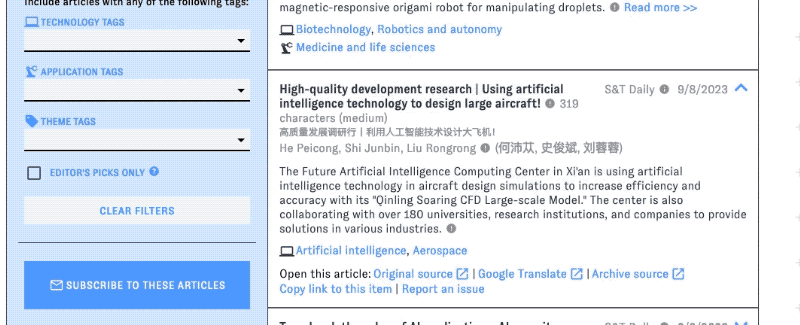
Use the filters in the left-hand column of the interface to winnow down to articles with particular tags or dates, or restrict to editors' picks only. You can also click on links to tags in the interface to add those tags to your selected filters.
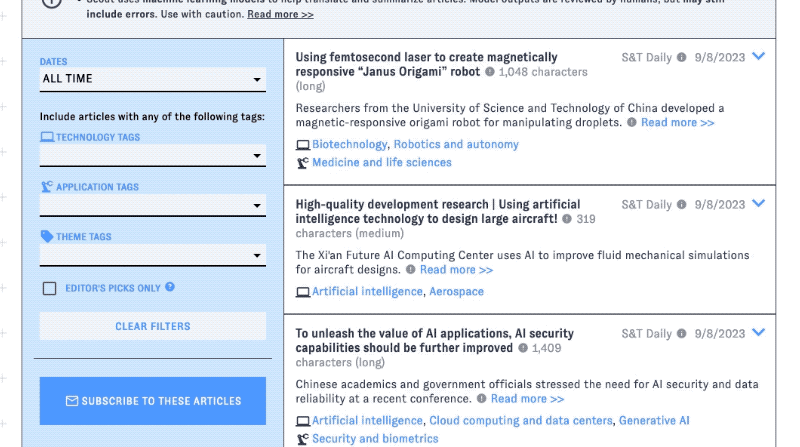
Click on the "Copy link to share" link in an article's expanded view to get a permalink to that article. This link is stable and will display the article on its own page - use it to share the article with colleagues, on social media, etc.
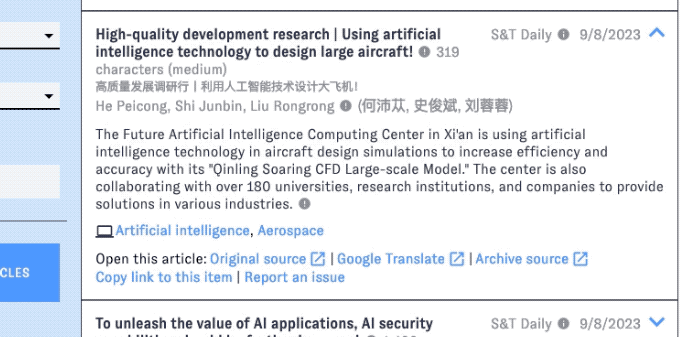
The email service
To begin setting up an email subscription, click the "Subscribe to these articles" button in the interface. The subscription dialog will launch, prepopulated with the filters that you had applied.
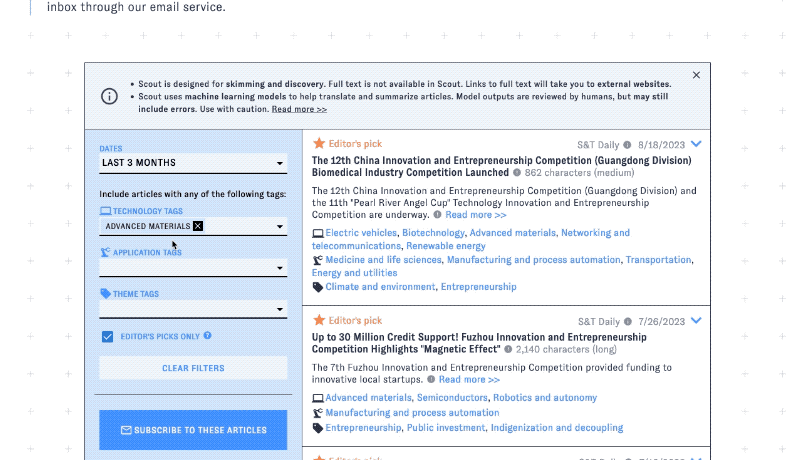
Once you've subscribed, you'll receive an email with a link to confirm your subscription. Click on that to complete your subscription.
You can have multiple subscriptions with different settings for the same email address. For example, you could receive daily emails with the latest editors' picks, plus monthly digests of all articles on agriculture or semiconductors.
Changing your subscription settings or canceling your subscription is easy. Click the link in the header of your latest Scout email, or have one sent using the subscription dialog in the web interface:
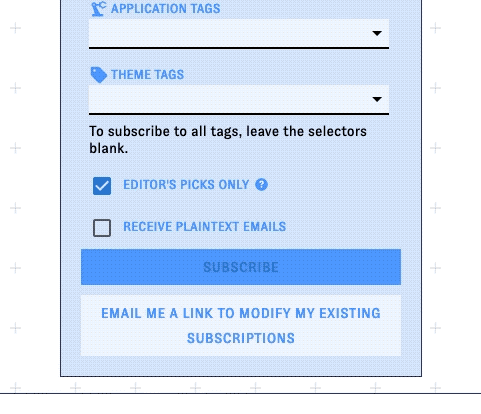
What can I use it for?
Use Scout to:
- Keep up with new developments in Chinese science and technology. Scout's UI is updated regularly based on the latest news and commentary from leading Chinese-language sources. Email digests are available daily, weekly, or monthly.
- Hear about topics, perspectives and trends often missing from English-language coverage. Scout compiles writing from diverse Chinese-language sources, from news articles in official media to op-eds, commentaries, and interviews from privately run tech outlets and think tanks. News from these outlets often doesn't make it into English-language media, or takes a long time to "filter through," and key details and perspectives may be lost along the way. Use Scout to bypass the filter and hear straight from Chinese sources.
- Identify specific sources and articles for further analysis. Scout's summaries and topical tags help you skim quickly and pinpoint the articles that interest you most. Try browsing for:
What uses are not recommended?
- Drawing conclusions about the overall perspectives or priorities of Chinese science and technology actors, or of China as a whole. Scout includes a wide range of writing relevant to critical science and technology issues, but it isn't comprehensive or representative of any one source or actor, let alone all Chinese-language writing on these topics. The content in Scout is selected from several different Chinese-language sources, not the entire Chinese-language internet, and doesn't include all of the content from the sources it does cover. To draw broader conclusions about trends in Chinese science and technology, we recommend using Scout alongside other tools and methods.
- Directly citing Scout summaries in published work. We recommend users cite the original articles summarized in Scout instead. Scout summaries are intended for skimming and discovery, not to serve as reliable sources on their own. Being summaries, they may not cover all aspects of the underlying articles. They are also partially machine-generated and may contain errors.
- Treating Scout as a substitute for reading the sources it covers. Scout is meant to help you generally keep up to date and discover relevant articles. Scout's summaries won't capture all or even most of the substance from the original articles, and it doesn't include full text. When you find articles that especially interest you, we encourage reading the full text at the original source.
- Any quantitative or otherwise complex analysis. We don't provide a bulk dataset of the articles or metadata included in Scout. Because of this, and because Scout isn't comprehensive in the first place (see above), we don't recommend using Scout for complex or quantitative analysis.
Sources and methodology
Sources and screening
Scout currently covers selected articles from the following sources:
- 36kr (36氪) - A Beijing-based, NASDAQ-listed web and mobile platform that aggregates technology-related content from online commentators and publishes some of its own original reporting, for a target audience of Chinese companies, institutional investors, local governments, and individuals.
- AI Tech Talk (AI科技评论) - A Chinese outlet featuring in-depth reports on developments in the AI industry and academia.
- Bulletin of the Chinese Academy of Sciences (中国科学院院刊) - A Chinese Academy of Sciences flagship journal focused on trends and strategic issues in China's scientific and technological development.
- CAICT (中国信息通信研究院) - White papers, data compilations, and other research outputs from the China Academy of Information and Communications Technology, a think tank under China’s Ministry of Industry and Information Technology.
- Caijing (财经) - A widely read and respected nonstate source for business, finance, and technology news.
- CASIA Research Trends (中国科学院自动化��研究所科研动态) - Research updates from the website of the Institute of Automation, a flagship AI research institute of the Chinese Academy of Sciences.
- CSET curation - Selections from CSET analysts' current Chinese-language reading.
- EE Times China (电子工程专辑) - A longstanding Chinese-language outlet for electronics industry news, analysis, and interviews. Established in 1993, EE Times China is owned by global media company AspenCore and is affiliated with EETimes-branded publications in the U.S. and many other countries.
- EEFocus (与非网) - A Chinese online portal for electronics industry news, analysis, and education that is owned by U.S.-based electronics industry services provider Supplyframe, a subsidiary of Siemens.
- Leiphone (雷锋网) - A Shenzhen-based portal for longform and shorter coverage on a range of science and technology issues.
- S&T Daily (科技日报) - A weekday newspaper published under the auspices of the PRC Ministry of Science and Technology.
- SASTIND (国家国防科技工业局) - Articles from the public website of China's State Administration of Science, Technology and Industry for National Defense.
- Zhidx (智东西) - A Chinese platform for news and commentary on technology issues, including artificial intelligence, consumer technology, and tech industry developments.
(We plan to add more sources over time. Feel free to suggest additions!)
Editors screen new articles from all these sources as they are released online. The screening process is subjective and involves editorial judgment, with the goal of keeping Scout's content diverse, substantive and relevant. Articles may be screened out for one or more of the following reasons:
- The article is actually another type of document (e.g., a video, advertisement, or other non-article file).
- The article is a summary of foreign science or technology developments without meaningful elaboration or commentary relevant to China.
- The article is an "explainer"-type feature without meaningful elaboration or commentary relevant to China.
- The reviewing editor determines that the article would not significantly advance most English-language readers' understanding of Chinese science and technology issues - for example, because it is vague, redundant, contains a lot of irrelevant material, or for other reasons.
Adding summaries, tags, and other metadata
After the initial screening, we use automated processes to extract and translate basic article metadata (title, author(s), source, date). A machine learning model generates draft short and long summaries, which human editors review against the original articles and revise as needed. Based on the summaries and full text, editors also apply tags for technologies, applications, and themes. The revised summaries, extracted metadata, and tags are reviewed by a second editor before publication.
Editors' picks
Editors also select a small number of articles as "editors' picks." Editors' picks reflect the informal, subjective judgment of Scout's editorial team about which articles will be most interesting to users. These are articles that the editorial team thinks are especially newsworthy or insightful, cover trends or perspectives that are especially unlikely to "filter through" to English-language media, or are otherwise unusually helpful for understanding Chinese science and technology issues. Editors' picks do not imply endorsement of the relevant articles or sources.
Scout editors' picks in your inbox
Maintenance
How is it updated?
The Scout web interface is updated several times a week as editors annotate, review and release new articles.
Scout email digests are sent daily (on weekdays only), weekly, or monthly, depending on the user's subscription settings. If there aren't any new articles meeting the user's settings, an email won't be sent for that period. For example, if a user subscribes to daily digests of agriculture-related articles only, and there aren't any new articles on agriculture in Scout one day, the user won't get an email digest that day.
How can I report an issue?
Use our general issue reporting form.
Credits
- Concept: Zach Arnold
- Design: Neha Singh, Jennifer Melot, Zach Arnold
- Editorial (current and former): Zach Arnold, Eileen Chen, Alexandra Fall, Ari Filler, Jennifer Hall, Robin Huang, Wenqing Ge, Timothy Goh, Sophia Lu, Erin Oppel, Tisyaketu Sirkar, Maya Snyder, Alina Thai, Adrian Thinnyun, Julio Wang, Andy Yang
- Engineering: Neha Singh, Jennifer Melot
- Review and testing: Catherine Aiken, Stephanie Batalis, Giacomo Bruni, Ilaria Carrozza, Kathleen Curlee, Hanna Dohmen, Jacob Feldgoise, Mia Hoffmann, Brian Love, Ngor Luong, Cole McFaul, Jennifer Melot, Ben Murphy, Neha Singh, and anonymous testers
- Documentation: Zach Arnold
- Maintenance: Neha Singh, Jennifer Melot
Major change log
| 9/20/23 | Initial release |